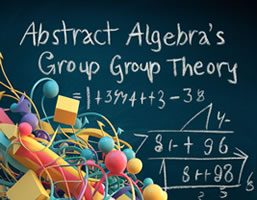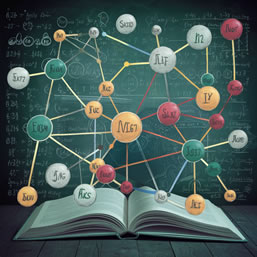STEM-KB Learning
 StemKB is an online learning platform dedicated to the STEM fields (Science, Technology, Engineering, Mathematics), providing valuable resources to help you explore these subjects. Here, you’ll find comprehensive guides and tutorials covering mathematics, technology, science, and engineering. In addition to theoretical concepts and practical examples, we also offer a section devoted to technological applications that enhance studying, learning, and knowledge sharing.
StemKB is an online learning platform dedicated to the STEM fields (Science, Technology, Engineering, Mathematics), providing valuable resources to help you explore these subjects. Here, you’ll find comprehensive guides and tutorials covering mathematics, technology, science, and engineering. In addition to theoretical concepts and practical examples, we also offer a section devoted to technological applications that enhance studying, learning, and knowledge sharing.
Groups
 Groups in the field of mathematics serve as the backbone for understanding the intricate concepts of symmetry and the foundational operations such as addition and multiplication. Defined by a collection of elements coupled with a binary operation that complies with closure, associativity, identity, and invertibility properties, groups are indispensable in the exploration of geometric structures, delving into number theory, and the broader spectrum of abstract algebra.
Groups in the field of mathematics serve as the backbone for understanding the intricate concepts of symmetry and the foundational operations such as addition and multiplication. Defined by a collection of elements coupled with a binary operation that complies with closure, associativity, identity, and invertibility properties, groups are indispensable in the exploration of geometric structures, delving into number theory, and the broader spectrum of abstract algebra.
Introduction to Graphs
 Expand your understanding of data structures with this essential guide to graphs. Perfect for beginners, it offers a comprehensive look at how graphs are applied to solve complex issues in computer science, applied mathematics, and more. Discover key concepts, illustrative examples, and hands-on applications simply by clicking the link.
Expand your understanding of data structures with this essential guide to graphs. Perfect for beginners, it offers a comprehensive look at how graphs are applied to solve complex issues in computer science, applied mathematics, and more. Discover key concepts, illustrative examples, and hands-on applications simply by clicking the link.
Mastering Matlab: A Practical Guide
 Our tailored guide demystifies Matlab for both novice and experienced users, offering direct and intuitive insights into its robust capabilities. With practical examples and case studies, we delve into how you can harness Matlab effectively across various applications, from mathematical modeling to data visualization. Our aim is to empower you with the skills needed to fully utilize Matlab in your academic pursuits or professional projects.
Our tailored guide demystifies Matlab for both novice and experienced users, offering direct and intuitive insights into its robust capabilities. With practical examples and case studies, we delve into how you can harness Matlab effectively across various applications, from mathematical modeling to data visualization. Our aim is to empower you with the skills needed to fully utilize Matlab in your academic pursuits or professional projects.
Octave Uncovered: A Comprehensive Guide
 Embark on a journey to master Octave, the open-source alternative for numerical computing and programming, with our in-depth online guide. Echoing many of Matlab's commands, Octave is an invaluable tool for tackling complex mathematical and engineering challenges efficiently. This guide provides step-by-step instructions, enriched with practical examples and detailed tutorials, to help you leverage Octave to its fullest potential.
Embark on a journey to master Octave, the open-source alternative for numerical computing and programming, with our in-depth online guide. Echoing many of Matlab's commands, Octave is an invaluable tool for tackling complex mathematical and engineering challenges efficiently. This guide provides step-by-step instructions, enriched with practical examples and detailed tutorials, to help you leverage Octave to its fullest potential.
Python Guide: Master Programming with Hands-On Examples
 This guide is meticulously crafted to offer you a thorough and insightful look into the world of Python programming. It's tailored to bridge the gap from fundamental principles for beginners to advanced concepts for seasoned developers. Featuring step-by-step tutorials, real-world examples, and professional insights, we're here to navigate you through the nuances of Python programming. Whether you're taking your first steps in programming or looking to enhance your existing skills, this guide serves as an ideal launching pad to delve into and master the intricacies of Python.
This guide is meticulously crafted to offer you a thorough and insightful look into the world of Python programming. It's tailored to bridge the gap from fundamental principles for beginners to advanced concepts for seasoned developers. Featuring step-by-step tutorials, real-world examples, and professional insights, we're here to navigate you through the nuances of Python programming. Whether you're taking your first steps in programming or looking to enhance your existing skills, this guide serves as an ideal launching pad to delve into and master the intricacies of Python.
Scilab
 Welcome to Scilab, the open-source powerhouse for numerical computing, perfectly suited for engineers, mathematicians, and scientists. Comparable to Matlab and Octave, Scilab offers a rich environment for solving complex mathematical problems. Our beginner's guide is designed to ease you into Scilab's interface, providing step-by-step instructions for basic calculations and an introduction to its more sophisticated functions. Join us as we delve into the essential features of Scilab, making your journey into scientific computing and data science both straightforward and engaging.
Welcome to Scilab, the open-source powerhouse for numerical computing, perfectly suited for engineers, mathematicians, and scientists. Comparable to Matlab and Octave, Scilab offers a rich environment for solving complex mathematical problems. Our beginner's guide is designed to ease you into Scilab's interface, providing step-by-step instructions for basic calculations and an introduction to its more sophisticated functions. Join us as we delve into the essential features of Scilab, making your journey into scientific computing and data science both straightforward and engaging.
A Primer on Machine Learning
 Explore the fascinating realm of machine learning, a cornerstone of computational sciences, characterized by algorithms that empower machines to learn autonomously. Delve into its diverse forms, including supervised, unsupervised, and reinforcement learning.
Explore the fascinating realm of machine learning, a cornerstone of computational sciences, characterized by algorithms that empower machines to learn autonomously. Delve into its diverse forms, including supervised, unsupervised, and reinforcement learning.
- Supervised Machine Learning
Understand the intricacies of supervised learning systems, which master data classification through initial examples. These systems are deemed 'supervised' as the learning trajectory is influenced by the examples chosen by the designer overseeing the project. - Unsupervised Machine Learning
Step into the world of unsupervised machine learning where training examples are unlabelled, presenting a unique challenge as the algorithm lacks predefined reference points for data classification. - Reinforcement Learning
Reinforcement learning stands out as a unique paradigm in machine learning. Here, an agent evolves through experience and feedback from its actions, guided by a reward-based system that encourages goal-oriented behaviors.
Neural Network
Discover neural networks, sophisticated computational models mirroring biological neurons. These interconnected artificial neurons are at the forefront of numerous practical applications, prominently in machine learning.

Deep Learning
Deep learning, a subset of machine learning, employs neural networks with multiple hidden layers, enabling a deeper and more complex processing of information layer by layer.
The Essence of Linear Regression
Linear regression, a statistical method, is used to model and analyze relationships between a dependent variable and one or more independent variables, assuming a linear interconnection. This technique aims to identify the line or multi-dimensional plane that best fits the data, minimizing the variance between observed points and the predicted line.

Hidden Markov Models (HMM)
A Hidden Markov Model (HMM) represents a sophisticated statistical approach, wherein a sequence of observable events is derived from an underlying, and typically unobservable, Markov process. Essential elements of an HMM encompass the presence of hidden states, a chain of observations, state transition probabilities, observation likelihoods, and the initial probability distribution of the states as the process commences.

Decoding AI, Machine Learning, and Deep Learning
While often interchanged, artificial intelligence, machine learning, and deep learning are distinctly different. Join us as we clarify these differences in detail.
Model-Based vs. Instance-Based Learning
Explore two pivotal approaches in machine learning: Model-based algorithms build models from training data, while instance-based algorithms rely on instances or examples for decision-making.







